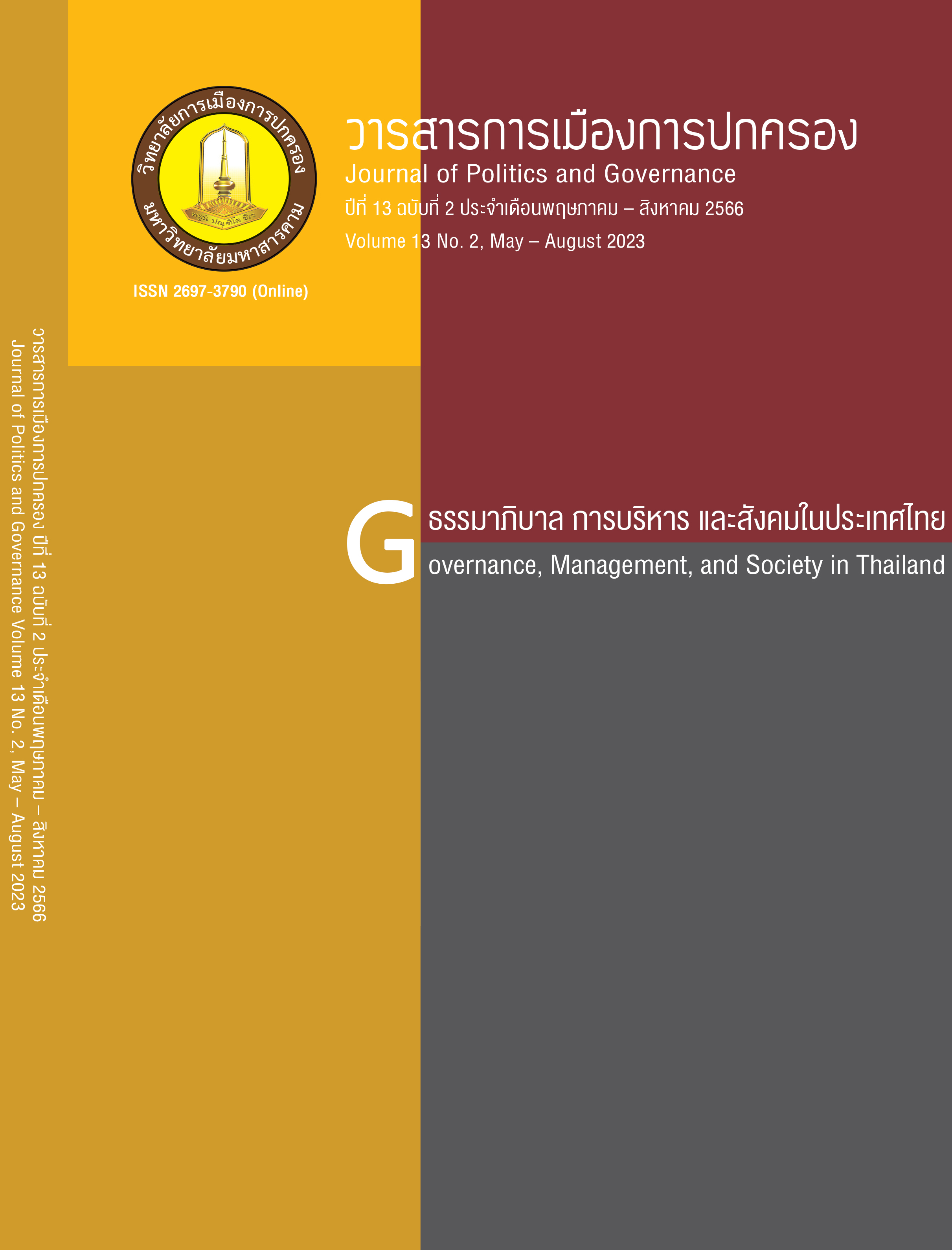Roles of Leadership on the Crisis Management in the Situations of the Corona Virus 2019 (COVID-19) Pandemic in Thailand
Main Article Content
Abstract
This article aims to study the roles of leadership on the crisis management in the situations of the COVID-19 pandemic. The outbreak is the test of administrators’ abilities on showing the leadership towards the urgent crisis management to reduce the impacts taken place in super spread and effective implementation. This is due to the COVID-19 pandemic is the Emerging Infectious Deceases (EID) that the global unexpectedly gains the impacts and hardly controls these ones. It was found that the roles of leaders are important to problem-solving management depending on “science” and “art” on job administrations. However, the roles of leadership towards the problem-solving of the country require to have high leadership in the following characteristics: Pathfinding, Effective work system, Inspiration, Communication, Life-long Learning, Emotional Intelligence, and Change Management that are crucial for leaders to have on their administrations under the crisis changing situations.
Article Details

This work is licensed under a Creative Commons Attribution-NonCommercial-NoDerivatives 4.0 International License.
References
กระทรวงยุติธรรม. (2564). Resilient Leadership ถอดบทเรียนผู้นำที่พร้อมรับมือกับความเปลี่ยนแปลงกับการจัดการโควิด-19. สืบค้นจาก https://www.moj.go.th/view/56154
จิรวัฒน์ สุริยะโชติชยางกูล. (2563). บทเรียนสภาวะผู้นำในสถานการณ์วิกฤตโควิด-19. สืบค้นจาก https://tdri.or.th/2020/01/covid-1/
ฐานริณทร์ หาญเกียรติวงศ์ และรุจิกาญจน์ สานนท์. (2563). ภาวะผู้นาการบริหารในภาวะวิกฤตสู่การพัฒนาอย่างยั่งยืน. วารสารเครือข่ายส่งเสริมการวิจัยทางมนุษยศาสตร์และสังคมศาสตร์, 3(2), 105-118.
เดลินิวส์. (19 ตุลาคม 2564). พิษโควิด-19 รอบ 3 SMEs ปิดกิจการ 2 หมื่นราย. สืบค้นจาก https://www.dailynews.co.th/economic/848070/
บุษบา สุธีธร. (2563). การบริหารการสื่อสารภาวะวิกฤตในโลกที่ผันผวนไม่ชัดเจน ซับซ้อนและคลุมเครือ. วารสารนักบริหาร, 40(2), 130-143.
พรชัย เจดามาน. (2556). ภาวะผู้นำการเปลี่ยนแปลง ศตวรรษที่ 21 : ไทยแลนด์ 4.0. สืบค้นจาก https://www.kroobannok.com/83312
พิชญ์ พงษ์สวัสดิ์. (2564). การบริหารจัดการโควิด ท่ามกลางสถานการณ์ที่เต็มไปด้วยความไม่แน่นอน. สืบค้นจาก https://www.matichon.co.th/article/news_2693260
ภาคภูมิ จตุพิธพร. (2563). การจัดการความเหลื่อมล้ำจากวิกฤตโควิด. สืบค้นจาก https://tdri.or.th/2020/10/inequalities-in-the-time-of-covid-19/
รัตติกรณ์ จงวิศาล. (2545). ภาวะผู้นำการเปลี่ยนแปลง. วารสารสังคมศาสตร์และมนุษยศาสตร์, 28(1), 31-48.
วลัยพร รัตนเศษ และสมศักดิ์ วานิชยาภรณ์. (2564). บทบาทของภาครัฐในการบริหารจัดการกับการแพร่ระบาดของโควิด-19. วารสารการบริหารและสังคมศาสตร์ปริทรรศน์, 4(2), 71-87.
สมชัย จิตสุชน. (2563). โควิด-19 กระทบใคร กระทบอย่างไร พวกเขารับมือไหวไหม. สืบค้นจาก https://tdri.or.th/2020/05/who-are-affected-by-covid-19/
สำนักงานการวิจัยแห่งชาติ. (2563). สรุปสถานะตามระยะของสถานการณ์การระบาดของโรคโควิด-19 ในแต่ละประเทศ. สืบค้นจาก https://www.mhesi.go.th/index .php/en/content_page/item/1588-covid-status-world20200517.html
สุริชัย หวันแก้ว. (2564). ยุคโควิด คิดแต่ไม่ถึง ความเหลื่อมล้ำทับซ้อนยุคดิจิทัล. สืบค้นจาก https://www.bangkokbiznews.com/blogs/columnist/126779
เสกสรร สนวา, ฉัตรณรงค์ศักดิ์ สุธรรมดี, และวิไลลักษณ์ ขาวสะอาด. (2561). คุณลักษณะของผู้นำองค์การภาครัฐสมัยใหม่. วารสารมนุษยศาสตร์และสังคมศาสตร์ มหาวิทยาลัยราชภัฏสุรินทร์, 20(พิเศษ), 399-411.
Barton, L. (2001). Crisis in organizations (2nd ed.). OH: College Divisions Southwestern.
Bass, B. M., & Avolio, B. J. (1994). Improving Organization Effectiveness Through Transformational Leadership. Thousand Oak: Sage.
Beilstein, C. M., Lehmann, L. E., Braun, M., Urman, R.D., Luedi, M. M., and Stüber, F. (2021). Leadership in a time of crisis: Lessons learned from a pandemic. Best Practice and Research: Clinical Anesthesiology, 35(3), 405-414.
Bennis, W. G. (1959). Leadership theory and administrative behavior. Administrative Science Quarterly, 4, 259-301.
Blanchard, K. H. (2019). Leading at a higher level: Blanchard on leadership and creating high performing organizations. (3rd ed.). London: Pearson Education.
Colonel, S.B. (2009). Leadership under pressure: tactics from line. India: Replika Press.
Coombs, W. T. (2007). Ongoing crisis communication: Planning, Managing, and responding (2nd ed.). Los Angeles: Sage.
Coombs, W. T. (2007). Protecting organization reputations during a crisis: The development and application of situational crisis communication theory. Corporate Reputation Review, 10(3), 163-176.
DuBrin, A. J. (1998). Leadership: Research Findings, Practice, and Skills. Boston, Massachusetts: Houghton Mifflin.
Fearn-Banks, K. (2001). Crisis communications: A casebook approach (2nd ed.). New Jersey: Lawrence Erlbaum.
Fener, T, & Cevik, T. (2015). Leadership in Crisis Management: Separation of Leadership and Executive Concepts. Procedia Economics and Finance, 26(2015), 695–701.
Fiedler, F. E. (1967). A Theory of Leadership Effectiveness. New York: McGraw–Hill.
Food and Agriculture. (2020). Addressing inequality in times of COVID-19. Italy: Rome.
Fox, R. L., & Schuhmann, R. A. (1999). Gender and local government: A comparison of women and men city managers. Public Administration Review, 231-242.
Gary A. Yukl. (1998). Leadership in Organizations. New Jersey: Prentice Hall.
James, E., & Wooten, L. (2005). Leadership as (un)usual: how to display competence in times of crisis. Organizational Dynamics, 34(2), 141-152.
Jaques, T. (2012). Crisis leadership: a view from the executive suite. Journal of Public Affairs, 12(4), 366-372.
Klann, G. (2003). Crisis leadership: Using military lessons, organizational experiences, and the power of influence to lessen the impact of chaos on the people you lead. Greensboro: Center for Creative Leadership.
Mitroff, I. I. (2011). From crisis management to crisis leadership. In Law L, editor. Business: The ultimate resource, 3, London: A & C Black.
Nelson, D. L., & Quick, J. C. (1997). Organizational Behavior: Foundations Realities, and Challenges. New York: West Publishing Company.
Petersen, E., Plowman, E. G., & Trickett, J. M. (1962). Business organization and management. Ohio: Irwin.
Tead, O. (1935). The Art of Leadership. New York: McGraw Hill.
The American Heritage Dictionary. (1985). The American Heritage Dictionary of Indo-European Roots. Boston: Houghton Mifflin Harcourt.
Tuz, M. V. (1996). Business Management in State of Crisis. Bursa: Ekin Bootstore.
Yukl, G. A. (1998). Leadership in organizations (7th ed.). New Jersey: Prentice-Hall.


